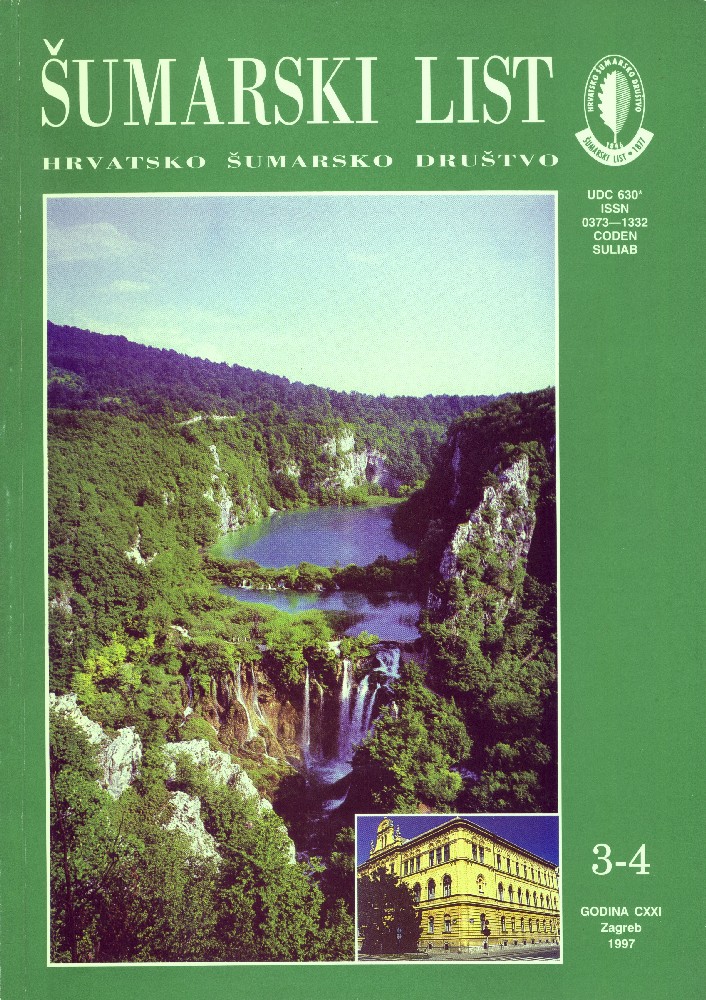
broj: 3-4/1997
pdf (25,5 MB) |
|
||||||||||||||
| IZVORNI ZNANSTVENI ČLANCI | ||
| Klepac, D. | UDK 630* 902 : 945+946.001 (497.13) | |
| Croatian Forestry in the Second Half of 19th Century pdf HR EN | 115 | |
| Trinajstić, I., Kamenjarin, J. | UDK 630* 188.001(497.13) | |
| Plantsociological analyses of holm oak - Quercus ilex L. Forests on Kozjak near Split (Croatia) pdf HR EN | 127 | |
| Bertović, S., Generalović, M., Karavla, J., Martinović, J. | UDK 630* 279.001 (497.13) | |
| Rijeka Parks and Nature Areas pdf HR EN | 133 | |
| Summary: A group of authors (Rijeka 1993) made a study that remained unpublished. Its contents, twenty authors and a preceding publication of the Rijeka nature and park distinctive features (Generalović) are presented. In terms of relief and karst formation, the Kvarner sector is the most distinguished and dynamic in all Croatian Littoral region. In the structure of the karst relief, the prevailing are Paleocene and Mesozoic carbonate rocks with paleocene fliss, paleozoic clastic layers and Quartär sediments in places. Submountainous, mountainous, hill and lowland orographic belts are the components of the relief. In the maritime climate of the whole greater Rijeka area, eight bioclimates are distinguished: subalpine, montane, submediterranean, hilly Mediterranean, and lowland. The Rijeka environment has been described according to the climatic classifications of Koppen, Thornthwaite and Walter. Enclosed are the maps of highland zones, orographic belts and analogue bioclimates, the tables of climatic figures and diagrams after Gaussen and Walter (Bertović). The interdependence of the lithological structure and soil types is described. According to the yet unpublished map, thirty-six pedocartographic units have been established in the Rijeka surroundings. There is a table-form statistic review of the main soil types and their properties (Martinovic). In the description of the vegetation cover, there are all climax phytocenoses, and the most distinguished locally conditionedparaclimax phytocoenoses on the cross-section of the submountainous peaks down to the coastline. Enclosed is a forest vegetation map of nature areas. Five sites of endemic flora and vegetation are suggested for a special legal protection as nature reserves. Further seven locations are suggested to serve for the follow-up bioecological research (Bertović). In the most detailed part of the study - the description of the decorative tree flora in Rijeka parks - sixty-six park areas have been studied: city parks, school parks, churchyards, hospital areas, kindergartens, sports grounds, camping sites and others. According to the dendrological inventory, the vegetation in these areas is composed of 75 conifer taxons, 228 broadleaved taxons and 35 perennials. Table titled "List of trees and perennial plants in the Rijeka and neighboring parks" marks the occurrence of the individual plant species in parks (1-66) and their numerical frequency (1-5; 5-10 and over 10 specimens). The oldest conifers are the Himalaya cedars (Cedrus deodara) in the Vladimir Nazor park; the pyramidal cypresses (Cupressus sempervirens var. sempervirens); Atlas cedar (Cedrus atlantica) and Lebanon cedar (Cedrus libani) in the Mlaka park. In the Kozala cemetery area there are old Himalaya ceders, 23 m high, 60 cm in diameter, a Lebanon cedar 27 m high, 28 cm in diameter. In the Trsat churchyard, a Chinese arbor vitae (Thuja orientalis) reaches the height of 17 m, 35 m diameter. Of the broadleaves, the oldest are the wild chestnuts (Aesculus hippocastanum) in the Mlaka park and the maple-leaved plane (Platanus x hispanica) 17 m x 65 cm. In the Kozala cemetery there is a 18m high, 38 cm in diameter Japanese sophora (Sophora japonica). A 13 m high and 75 cm in diameter bitter oak (Quercus cerris) grows on the Trsat churchyard beside a 14 m high and 170 in diameter pubescent oak (Quercus virgiliana). The following have been recommended for a special legal protection: August Cesarec Park; Mlaka Park, Vladimir Nazor Park; the Old Park Of "Katica Mitel Katinka"; Vidov Park, Trsat Park, Kozala cemetery park and the Trsat churchyard. The multitude of decorative taxons in the Rijeka park areas with the improvement of the ornamental horticulture nursery activities in all Croatian Littoral can be maintained only if this vegetation is respected, protected and regularly improved (Karavla). | ||
| STRUČNI ČLANCI | ||
| Böhm, D. | UDK 630* 279 : 907.1 (497.13) | |
| Current Issues on the Protection and Preservation of the Plitvice Lakes National Park pdf HR EN | 161 | |
| Jurković, M. | UDK 630* 279. (497.13) | |
| The Botanical Garden of the School in Kaštel-Lukšić pdf HR EN | 171 | |
| Ivan Maričević | UDK 630* : 013* (497.13) | |
| Index of Authors and Content Structure of Šumarski list 1976 - 1995 PDF | 179 | |


